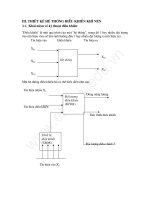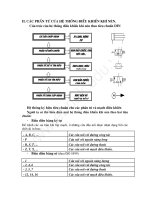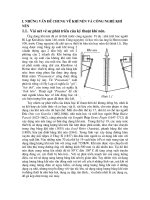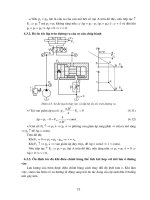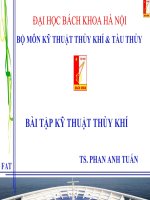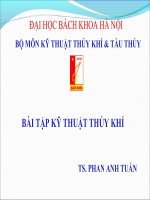Bài tập Kỹ thuật Thủy lực và Khí nén có đáp án (Tiếng Anh)
Bạn đang xem bản rút gọn của tài liệu. Xem và tải ngay bản đầy đủ của tài liệu tại đây (9.35 MB, 688 trang )
Power
Pneumatics
Chapter 1: PNEUMATIC PRINCIPLES
1. A body has a mass of 1 kg. What is its weight
a) On earth in a gravitational acceleration of 9.81 m/s2?
b) On a smaller planet ‘Pneumo’ whose gravitational acceleration is 6 m/s2?
Solution:
Weight on earth = Mass x Acceleration
= 1 kg x 9.81 m/s2
= 9.81 kg.m/s2
= 9.81 newtons (N)
Weight on planet ‘Pneumo’ = Mass x Acceleration
= 1 kg x 6 m/s2
= 6 kg.m/s2
= 6 newtons (N)
A mass of 1 kg is suspended on a spring balance in a lift cage. The maximum
acceleration of the lift both ascending and descending is 3 m/s2. If the spring balance is
calibrated in kg what will be its reading at maximum acceleration when
a) Ascending?
b) Descending?
Solution:
(a) With the cage ascending the spring balance will be accelerated upwards at a maximum
rate of 3 m/s2. To the spring balance it will appear that the mass is being pull downwards
with a acceleration of 3 m/s2 in addition to the gravitational acceleration.
Figure 1.1 Acceleration of the cage upward
Total acceleration is 9.81 + 3 m/s2. Weight will be
1 x (9.81 + 3) N = 12.81 N
As the spring balance is calibrated in kg in will read
1
12.81N
1.306kg
9.81m/s
(b) Effective acceleration on weight = (9.81 - 3) m/s2. This time the reading on the spring
balance will be
9.81 3
9.81
0.694
A pneumatic cylinder with a bore of 100 mm is to clamp a component with a static
force of 3000 N (see Fig. 1.3). Determine the required air pressure.
Solution:
=
Area of cylinder
=
=
D2
2
1002
mm 2
2
0.12 2
m
2
= 7.85 103 m 2
Figure 1.2 Arrangement of the clamp cylinder
System pressure
=
= Force / Area
3000 N
7.85 103 m 2
= 382 103 N / m 2
= 3.82 105 N / m 2
= 3.82 bar
2
The system pressure acts on one side of the piston and is opposed by atmospheric
pressure acting on the other side. The system pressure has therefore to overcome the
atmospheric pressure and exert a thrust of 3000 N. The pressure registered on a gauge is
the pressure above atmospheric.
Taking atmospheric pressure as 1 bar absolute, then
System pressure
= 3.82 bar gauge
= 3.82 bar+ 1 bar absolute
= 4.82 bar absolute
3
A compressor delivers 500 m3 of free air per hour at a pressure of 7 bar gauge and a
temperature of 40 oC. The atmospheric air at the compressor intake has a relative
humidity of 80 percent and a temperature of 20 oC. Determine the amount of water that
has to be extracted from the compressor plant per hour.
Solution:
At 20 oC and 0 bar (gauge), 100 m3 of free saturated air contains 1.73 kg of water. At 80
percent humidity the water content is 1.384 kg per 100 m3 f.a.d. Air at the compressor
plant outlet will be saturated. Water content per 100 m3 f.a.d at 7 bar gauge and 40 oC
by interpolation is
0.728 0.567
0.647 kg
2
Thus water content of air entering the compressor plant per hour is
5 1.84 kg
Water content of air leaving the compressor plant per hour is
5 0.647 kg
Thus, the amount of water that has to be extracted from the compressor plant per hour is
5 (1.384 0.647) kg 3.68 kg
A compressor delivers 3 m3 of free air per minute at a pressure of 7 bar gauge.
Assuming that the compression follows the law PV1.3 = const, determine the theoretical
work done.
Solution:
Work done =
Where n = 1.3
P1 = atmospheric pressure = 1 bar abs
V1 = 3 m3/min
P2 = 7 bar gauge = 8 bar abs
.
.
.
Work done =
.
.
8
0.61
1
3
3
.
0.61
/
10
4
8.15
13.58
10
10
/
But 1 N m/s = 1 watt; therefore, work done =13.58 kW
Calculate the work done if the air in Example 1.5 is compressed isothermally.
Solution:
P1 = 1 bar abs
V1 = 3 m3/min
P2 = 8 bar abs
Work done = 1
3
10 ln
.
/
/
/
= 10.4 kW
For a two-stage compressor delivering air at a pressure of 7 bar gauge, determine the
intercooler pressure for minimum input power
Solution:
7
1
1
2.82
1.82
Estimate the pressure drop over 100 m of pipework of 50 mm bore with a flow rate of
100 l/s. The mean pressure in the pipe maybe taken as 5 bar gauge. Take f as 500, then
Solution:
∆
Where f = 500
L =100 m
Q = 100 l/s
D = 50 mm
Pm = (5 + 1) bar abs
Therefore,
5
500
∆
100 100
50
6
0.27
Any pressure drop in the pipework is a loss of energy and, as a consequence, an increase
in operating costs. Increasing the bore of the pipe will reduce the pressure drop but
increase the cost of the pipe. These must be balanced against each other for optimum
conditions. If the pipe bore is increased to 60 mm the pressure drop is given by
500
∆
100 100
60
6
0.107
A compressor delivers 200 l/s f.a.d. at a pressure of 7 bar. Assuming the maximum
flow velocity of 6 m/s, estimate the pipe diameter needed.
Solution:
The compressed volume of air flowing will be the free air delivery divided by the
compression ratio, where
Thus, in this case, taking atmospheric pressure as 1 bar,
7
1
8
200
8
25
1
25 /
10
4
6
Where d is the bore of the pipe in metres. Thus,
25
4
6
10
0.073
73
In this case an 80 mm bore pipe would be used.
6
Chapter 2: PRODUCTION AND DISTRIBUTION OF
COMPRESSED AIR
An air compressor delivers 10 m3/min f.a.d. at a pressure of 7 bar. The average circuit
demand being 7 m3/min f.a.d. with an allowable fluctuation of delivery pressure of from
7 to 6 bar. Assuming that a receiver having a capacity of 4 m3 is used, determine the
number of times the compressor comes on load per hour. Assume the air is fully cooled
and its temperature is constant. All pressure are gauge, and atmospheric is 1 bar
absolute.
Solution:
To find the quantity of free air stored in the air receiver apply the characteristic gas
equation:
(a) At 7 bar gauge
P1 = 1 bar abs
V1 = ?
P2 = (7+1) bar abs
V2 = 4 m3
8
4
32
1
(b) Similarly, at 6 bar gauge
P3 = 1 bar abs
V3 = 4 m3
P4 = (6+1) bar abs
V4 = ?
7
4
1
28
The difference in the volume of free air stored in the receiver between 7 bar and 6 bar
pressure is 4 m3. The compressor will come on load when the receiver pressure falls to 6
bar and go to off load when it reaches 7 bar. The compressor delivers 10 m3/min f.a.d.
This leaves 3 m3/min to charge the receiver. Thus,
4
3
1.33
/
The receiver discharges from 7 bar to 6 bar gauge supplying the system. There is a 4 m3
f.a.d. during this time. Thus,
4
7
/
0.57
7
This is the total time between the compressor going on load is:
1.33
0.57
1.9
The represents 31.6 starts per hour, which is too many, so the receiver size must be
increased to, say, 6 m3. This will increase the quantity of air stored between the pressure
of 6 and 7 bar gauge to 6 m3.
So
6
3
2
/
6
7
0.86
/
This gives a cycle time of 2.86 min, which is acceptable. The cycle time can be
increased by either increasing the capacity of the receiver or increasing the range of
pressures over which the system can function.
A double-acting pneumatic cylinder with a bore of 100 mm, a rod diameter of 32 mm
and a stroke of 300 mm operates at a pressure of 6 bar gauge on both extend and retract
strokes. If the cylinder makes 25 complete cycles per minute calculate the air
consumption.
Solution:
Calculate the swept volume extending and retracting
100
4
300
Therefore,
100
4
2.355
300
32
4
100
300
2.114
Total volume of compressed air per cycle is:
2.355
2.114
4.469
4.469
111.7 /
25
To express this in term of free air, the volume the air would occupy at atmospheric
pressure has to be calculated, taking atmospheric pressure as 1 bar absolute.
Then, by the gas law,
8
Assunming isothermal conditions and expressing the pressure as an absolute value, then
P1 = 1 bar abs
V1 = Air consumption f.a.d.
P2 = 6 bar gauge = 7 bar abs
V2 = 111.1 l/min
And
T1 = T2
Substituting in
7
111.7
782 / min . . .
Calculate the percentage reduction in air consumption per minute for the cylinder in
Example 2.2, if the supply pressure used during the retract stroke is 2 bar gauge.
Solution:
From previous calculation:
Retract volume per stroke = 2.114 litres
The retract stroke is at 2 bar gauge, so volume of free air per retract stroke is given by
Or
2
1
1
2.114
6.34
. . .
From previous calculation:
Extend volume per stroke = 2.355 litres
The extend stroke is at 6 bar gauge, so volume of free air for the extend stroke is
obtained using the formula
Or
6
1
1
2.355
18.48
. . .
Total air consumption per cycle is
18.48
6.34
24.82
. . .
At 25 cycles/min the air consumption is:
24.8
25
620 / min . . .
9
The air consumption calculated in Example 2.2 – when they extending and retracting
pressures were 6 bar gauge – was 782 l/min f.a.d. By reducing the retract pressure to 2
bar gauge the air consumption was reduced to 620 l/min f.a.d. The percentage reduction
is
782
782
620
100
20.7%
Consider the cylinder details given in Example 2.2. Calculate the increase in air
consumption when the pipework between the valve and the cylinder is taken into
account. The bore of the pipe is 12 mm and the distance between the cylinder and the
valve is 1 m.
Solution:
1000
Volume of pipework =
2
226.224
0.226
Both pipes are pressurized to 6 bar gauge once per cycle or 25 times per minute.
Note: one pipe is pressurized on the extend stroke; the other pipe is pressurized on the
retract stroke. Thus the volume of air used in pressurizing the pipework is:
0.226
6
1
25
1
39.6 / min . . .
A pneumatic ring main supplies a plant with an average demand of 20 m3/min f.a.d.
The minimum working pressure at the receiver is 5 bar gauge. The air compressor has a
rated delivery of 35 m3/min f.a.d. at a working pressure of 7 bar gauge. The control
system switches the compressor off load when the receiver pressure reaches 7 bar gauge
rising, and back on load when the receiver pressure is 5 bar gauge falling. If the
maximum allowable of starts per hour of the compressor is 20, determine a suitable
receiver capacity.
Solution:
As the compressor is limited to 20 starts per hour, the minimum time between starts is 3
minutes, assuming steady operating conditions.
In 3 minutes the system demand is 3
must run for:
3
20 m3 f.a.d. To supply this the air compressor
20
35
1.174
Thus the compressor is off load for 1.286 min during which time the receiver has to
supply the air required by the system while the pressure in the receiver falls from 7 to 5
bar gauge. Therefore,
Volume of air supplied from receiver = 1.286
20
25.72
. . .
Let V be the actual volume of the receiver; the volume of free air stored in the receiver
at 7 and 5 bar gauge can be calculated and equated to the required volume. Assume that
the air in the receiver is at constant temperature or that any change in temperature is too
small to significantly affect the calculations.
10
Volume of free air in receiver at 7 bar =
8
Volume of free air in receiver at 5 bar =
6
So volume of free air available from the receiver as the pressure falls from 7 bar to 5 bar
gauge is equal to:
8
6
2
The volume of air to be supplied is, as calculated previously, 25.72 m3. Hence
2
25.72
12.86
Thus the volume of the receiver required is 12.86 m3.
Select a 13 m3 receiver. Some of the volume of the pipework in the ring main can be
considered as part of the receiver, and so increase the effective capacity of the receiver.
The air demand from the plant in Example 2.5 has reduced to 15 m3/min f.a.d. The
same compressor of 35 m3/min f.a.d. at 7 bar gauge together with a 13 m3 receiver are
used. Calculate the number of starts per hour of the compressor if the same switching
pressures of 7 bar and 5 bar gauge are used.
Solution:
Volume of air stored in receiver at 7 bar is
13
7
1
1
104
. . .
78
. . .
Volume of air stored in receiver at 5 bar is
13
5
1
1
Therefore, the volume of air available from receiver between 7 bar and 5 bar pressure is
104
78
26
. . .
The system demand is 15 m3/min f.a.d., thus the air stored in the receiver will run the
system for 1.734 min
When the receiver is being charged the volume of air entering the receiver is the
difference between the compressor output and the system demand. In this case:
35
15
. . . of air flow into the receiver
20
Thus the time taken to charge the receiver is taken for 20 m3 f.a.d. of air flow into the
receiver. Thus,
26
20
1.3
The cycle time for the receiver, i.e.
11
Charge plus discharge time = 1.73 + 1.3 = 3.03 min
This gives the number of starts per hour as
60
3.03
19.9
This is less than suggested 20 starts per hour given in Example 2.4 and so is
satisfactory. It must be noted that since the usage rate of air has fallen, so has the
charging time.
Consider the compressor plant designed in Example 2.4 but with the system demand
increased from 20 to 25 m3/min f.a.d. Calculate the number of times the compressor
switches on load per hour. If the number of compressor starts is to be 20 per hour,
determine the receiver pressure at which the compressor switches on load. The off-load
pressure is to remain at 7 bar.
Solution:
As before, the volume of air stored in the receiver between 7 and 5 bar gauge us 26 m3
f.a.d. At a demand of 25 m3 f.a.d.:
1.04min
Receiver discharge time =
Again, with the demand at 25 m3/min f.a.d., there will be (35 – 25) m3/min f.a.d. to
charge the receiver. Thus
Receiver charge time =
2.6min
Receiver cycle time = 1.04 + 2.6 = 3.64 min
This give 16.5 starts per minute.
Let the difference in the pressure settings be P bar, then the volume of air available from
the receiver for the pressure difference is the receiver volume times the pressure
difference. Therefore,
Volume of air available = 13 P m3 f.a.d.
This volume of air will run the plant for a time equal to
13 P
25
This is the discharge time for the receiver. To calculate the charge time for the receiver,
divide the volum of air that has to flow into the receiver (13 P in this case) by the
excess flow supplied by the compressor, which is the compressor delivery less the
system demand (35 – 25 m3/min f.a.d in this case).
Receiver charge time =
Receiver cycle time =
min
12
To give less than 20 starts per hour the cycle time must be greater than 3 minutes.
Therefore,
13P
25
13P
10
1.82P
P
3
3
1.65bar
So the on-load pressure is 5.35 bar
A machine has an air demand of 0.1 m3 f.a.d. per cycle at a minimum pressure of 4 bar
gauge and operates at 25 cycle per minute. The machine is supplied from a ring main in
which the pressure varies between 7 and 3 bar gauge linearly over a 20 second cycle
time. Estimate the size of a receiver to be placed between the machine and the ring main
to maintain a minimum pressure of 4 bar gauge at the machine. Variations in ring main
pressure is assumed cyclic, as shown in Fig. 2.18.
The ring main falls below 4 bar pressure for a total time of 5 seconds per cycle
variation. This is the time for which the receiver must store sufficient air to operate the
machine between the maximum pressure of 5 bar, the average ring main pressure and a
minimum of 4 bar.
Solution
Let the receiver volume to be V. The volume of air in the receiver at 5 bar is:
V
5
1
. . .
1
The volume of air in the receiver ai 4 bar is:
V
4
1
. . .
1
Therefore, the volume of air available from the receiver is:
V
5
1
1
V
4
1
1
. . .
13
Figure 2.1 Cyclic pattern of pressure fluctuations in a ring main system
The volume of air required by the machine during 5 seconds is the air consumption per
cycle times the machine cycles in 5 seconds, that is:
0.1
25
60
5
0.208m . . .
Thus the minimum volume of the receiver is obtained by equating (1) and (2). That is,
V
0.208m
In a test on a ring main it was found that when the receiver was fully charged to 7 bar
and then isolated from the compressor it took 10 minutes for the pressure to fall to 6.5
bar gauge. The receiver has a capacity of 20 m3 and the ring main aa bore of 100 mm
and a length of 800 m. Estimate the leakage rate from the system. If the total input
power is 100 kW, estimate the percentage of the input power used in supplying air to
the leaks.
Solution:
.
Volume of ring main =
800
6.28
The total capacity of the receiver and the ring main is
20 + 6.28 = 26.28 m3
The volume of air released from the receiver and the ring main when the pressure falls
from 7 bar to 6.5 bar gauge is
(7 – 6.5) 26.28 = 13.14 m3
This leaks from the system in 600 seconds, so the average leakage rate is:
13.14
600
0.0219
. . .
Or the leakage rate from the system at an average pressure of 6.75 bar gauge is 1.314
m3/min f.a.d.
At previously stated, 75 litre/min f.a.d. at a pressure of 7 bar gauge requires an input of
1 kW. Therefore, the power required to supply 1.314 m3/min at 6.75 bar gauge is:
1.314 1000
75
6.75 1
7 1
16.97
Thus, the percentage of input power used in supplying air leakage is:
16.97
100
100
16.97
14
Chapter 3: VALVES
From the chart in Fig. 3.18, a supply pressure of 6 bar (P1) and an outlet pressure of 5
bar (P2) gives a flow rate Qn of 1500 l/min.
If, from the previous conditions, the outlet pressure (P2) falls to 4 bar the flow rate Qn
will increase to 1900 l/min.
Chapter 4: ACTUATORS
A double acting cylinder is required to clamp a workpiece with an actual force of 3kN.
The minimum supply pressure is 5 bar, cylinder return is at minimal load. Calculate the
cylinder size required assuming an efficiency of 96 percent.
Solution:
Therefore,
3000
5
0.96
10
0.00626
Now
4
Therefore,
4
4
0.00626
0.0893
89.3
In this instance one would select a 100 mm bore cylinder since this is the nearest
standard bore cylinder that will satisfy the force requirement.
A pneumatic cylinder is required to move 200 kg packs of paper 600 mm up a 600
incline. The coefficient of friction is 0.15. It is to be assumed the acceleration of the
load will occur within the cushioned length (30 mm) and that the load will attain a
velocity of 0.6 m/s/ The maximum pressure available at the piston is 5 bar gauge,
determine:
a) The actuator size required
b) The air consumption if the cylinder operates at 15 cycles/min
Solution:
Determine the total force opposing motion
15
sin 60
200
9.81
sin 60
1699
200
cos 60
9.81
0.5
0.15
147
2
From the equation of motion
If we accelerate from rest
2
200 0.6
2 0.03
1699
147
1200
Internal friction = 0.1
Total resistance R
1200
3046N
1.1
3046N
.
Piston diameter =
3046
0.085
85
The nearest standard cylinder that would satisfy this application would be 100 mm
diameter (see Table 4.2).
To ascertain the quantity flow requirements, it is necessary to determine the
displacement of the cylinder and the number of cycles per minute.
1.
Cylinder (extend)
Q
2.
π
D
4
Cylinder (retract)
16
Q
3.
4
Cylinder (extend and retract)
2
Q
4
Where Qext = quantity of air to extend the cylinder per minute (m3/min)
Qret = quantity of air to retract the cylinder per minute (m3/min)
Qtot = quantity of air to extend and retract the cylinder per minute (m3/min)
D = diameter of full bore side (m)
d = diameter of piston rod (m)
L = length of stroke (m)
n = number of cycles per minute
P1 = supply pressure (bar)
P0 = atmospheric pressure (bar)
2
Q
π
0.73
4
2
0.025
0.1
4
m
min
73
dm
min
0.8
12.17
dm
s
15
5
12.17
1
1
l
s
A pneumatic cylinder complete with a direction control valve and associated pipe and
fittings has been selected to move a mass of 3 kg with a supply pressure of 8 bar.
Estimate the extend stroke time.
Solution:
The manufacturer’s data for cylinder is:
D = 50 mm
L = 240 mm
Lc = 29 mm
And for the valve is:
Ce = 2.76
T1 = 0.05
Time required to reach the cushion = T2
17
T
1.2 L L D
C
10
1.2 240 29
2.76 10
50
0.229
Altenatively,
0.05 L
m
P
L
T
0.05 240
D
29
3
8
50
0.129
In this instance the time is not affected by the cushion requirements as T2min is less than
T2
From the formula V1 = 30D/m, the maximum cushion velocity can be estimated as:
30D
m
V
30
50
500
3
mm
s
Since the velocity exceeds 300 mm/s, then 300 mm/s is adopted.
L
V
T
29
300
0.097s
The actual minimum stroke time = T1 + T2 + T3:
0.05 +0.229 +0.097 = 0.376 s
Using the same components as the previous example but with the load increase to 15
kg, determine the stroke time.
Solution:
From the previous question
T1 = 0.05 s and T2 = 0.229 s
0.05 L
m
P
L
T
0.05 240
D
29
50
15
8
0.289
Since T2min is greater than T2 the exhaust requires to be restricted in order to provide
effective cushioning. The conductance corresponding to T2min is:
C
1.2 L
T
L D
10
1.2 240 29
40
0.289 10
1.402
Time durin cushioning is:
V
30D
m
T
L
V
30
50
15
100
mm
s
18
Therefore,
T
29
100
0.29s
T
0.05
0.289
Therefore, total time is:
T
T
T
0.29
0.629s
In a vertically mouted cylinder application a mass of 5 kg is driven downwards at 1.5
m/s by a supply pressure of 8 bar. The maximum working pressure of the cylinder is 10
bar. Determine a cylinder size that will provide adequate internal cushioning.
Solution:
E
mV
2
F .E
1.5
2
1.5
Where m = 5 kg
V =1.5 m/s
Fx = 1.5
Therefore,
5
E
5 1.5
2 1.5
E
E
3.75Nm
Cylinder selection shows that, 32 mm diameter has 4 Nm Ecush potential.
Determination of cushioning pressure (Pcush) is
P
p
10
F
a
Where Fe = Mass Acceleration due to gravity
= 5 kg 9.81 m/s2
= 49.05 N
Therefore,
P
8
10
49.05
800
8.6bar
Hence, since the cushioning pressure is less than the maximum working pressure, a 32
mm bore cylinder can be braked effectively.
19
In a vertically mounted cylinder application a mass of 24 kg is driven upwards at 1.8
m/s by a supply pressure of 6 bar. If the maximum working pressure is 10 bar determine
a cylinder size that will provide adequate internal cushioning.
Solution:
E
mV
2
F .E
1.8
2
1.8
Where m = 24 kg
V =1.8 m/s
Fx = 1.8
Therefore,
24
E
24
2
E
1.8
1.8
E
21.6Nm
Cylinder selection shows that, 63 mm diameter has 29.8 Nm Ecush potential.
Determination of cushioning pressure (Pcush) is:
P
P
10
F
a
Where Fe = Mass Acceleration due to gravity
= 24 kg 9.81 m/s2
= 235.44 N
Therefore,
P
6
10
235.44
3110
5.24barbar
Calculation confirms that a 63 mm bore cylinder is suitable.
A 50 mm diameter cylinder, having a stroke of 5000 mm, is to carry an external load
of 1400 N. If the maximum deflection is not to exceed 1 mm, determine the number and
oitch of ther supports.
Solution:
A1 is determine from manufacturer’s data. In this case we will use 300 mm.
t
A
Stroke
L
300 5000
1700
3.18
Actual length between pitches, support method L:
20
L
Stroke
A
t
Tsel = 4. Thus:
L
300
5000
4
1325
Actual length between pitches, support method (d):
L
Stroke
A
300
t
5000
4.5
1178mm
Since alternatives are below the maximum value of that stated, both are acceptable
methods of support.
Chapter 5: Cylinder Control
A wire basket containing red hot steel components is to be lowered slowly into an oil
quench bath, as shown in Fig. 5.6. The basket has to be stopped and held in any
position, the baskets stopping accuracy is unimportant. Devise a pneumatic circuit and
estimate the bore of a suitable pneumatic cylinder to ISO recommended sizes. The total
basket weight with components is 60kg and the maximum air supply pressure available
is 5 bar gauge.
c
Solution:
21
Use a 5/3 closed center valve with exhaust restrictors, as shown in Fig. 5.7. The exhaust
restrictors are adjusted so that a fully loaded basket will just raise or lower when the valve
is operated. In sizing the cylinder, it must be noted that there will be a considerable back
pressure; and in a case such as this when the cylinder is extending slowly with the load
assisting the motion, the back pressure will be greater than the supply pressure. When the
wire basket is being raised, the load and the back pressure oppose the motion of the
cylinder, and the cylinder size must be calculated under this condition. The retract thrust
of the cylinder must overcome the load and the back pressure (see Fig. 5.8).
If the full bore area of the piston is A, the rod area is a, the air supply pressure is , and
the back pressure is , then equating forces on the piston:
60
. If we assume
When the exhaust restrictor is adjusted it will vary the back pressure
that is 60 percent of the supply pressure, then
0.6
0.6
5
10
60
5
/
60
9.81
. Then equating forces across the piston, assuming no
Let the units for A and a be
acceleration,
0.6
5
10
60
9.81
5
10
The rod area of a standard pneumatic cylinder if small compared with full bore area and
may be neglected in this case. Then
0.6
5
0.6
If the cylinder bore is , then
10
9.81
60
9.81
0.4
5
60
2
9.81
10
5
10
10
, or
22
60
2
4
9.81
10
Thus,
4
4
62
60
2
60
2
9.81
10
9.81
10
10
62
The nearest standard cylinder is 63 mm bore, which is very chose to that calculated and
as the rod diameter has been neglected it would be advisable to use the next size higher,
i.e. an 80. Mm bore cylinder. A 63 mm bore cylinder could be used if the exhaust
restrictor was adjusted to reduce the back pressure to a value below 60 percent of the
supply pressure.
A pneumatically operated machine is shown diagrammatically in Fig. 5.36. It is to feed
a component from the magazine and the clamp it. As a component is fed to the clamp it
ejects the previous one. The sequence of operations is to be: feed component, clamp,
retract feed cylinder and then unclamp. The sequence is to be continuous provided there
are components in the magazine.
As a safety feature the clamp cylinder must be powered forward in the event of a
failure in the air supply.
Solution:
The sequence will be:
23
As the clamp cylinder has to clamp the component and not extend to a fixed
position, pressure sensing must therefore be used to detect the B+ condition. The
machine must stop when the magazine is empty and a valve must be incorporated in the
circuit to stop the cycle when this occurs.
In the event of air supply failure, the clamp cylinders must be energized. This can be
achieved by using a spring offset cylinder control valve and an air reservoir.
Figure 5.37 shows a possible circuit for this machine. The sequence is initiated by a
signal from trip valve b0 passing through the magazine trip valve, provided there is a
component present, onto the stop run valve to give an A+ signal.
Cylinder A extends and operates trip a1 which is an air reset valve. When this trip is
operated it switches off the B- signal to the spring offset valve VB, which allows the
spring to reset the valve, extending the clamp cylinder B. When cylinder B is fully
clamped there will be zero air pressure in the annulus side and on the pilot of the
diaphragm valve b1, which resets under the action of its spring, sending an A- signal to
valve VA. Cylinder A retracts, operating trip valve a0 which sends a signal to reset trip
valve a1 which, in turn, gives a B- signal. Cylinder B retracts, operating trip valve b0
and the sequence is ready to restart.
Should there be a failure of the air supply, valve VB will be reset by its spring
causing air from the reservoir to flow to the full bore side of cylinder B energizing the
clamp. The check valve by the air reservoir stops the air from the reservoir discharging
if the supply is at fault. It is advisable to fit a shut-off valve to the reservoir to allow it to
be discharged when required.
24

